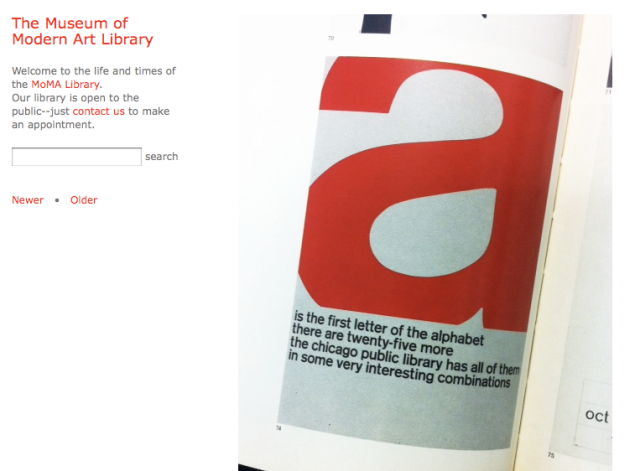A social media form that I have been curious about but have never used is tumblr. A friend recently suggested that I look into it. The basic format of a tumblr feed looks intriguingly simple and eye-catching. “Tumblr makes blogging blissfully easy” (NYT); “…microblogging done right” (cnet); and “Obama’s top 5 tech tools” (PC World) are among the variety of approving quotes displayed on Tumblr’s “About” page. These are nested below images of young, contented-looking tumblr staff eating lunch together and working on desks beside large bay windows in exposed brick offices. On the other hand, mono.blog dismisses tumblr as: “…[rarely] even remotely interesting – often they’re just mood boards full of more things to buy”.
Tumblr hasn’t seemed to catch on much within organizations, but in December 2011, it caught on at MOMA Library, when a tumblr page was launched by David Senior, house librarian and bibliographer. Unless I’m missing something, a visit to either MOMA’s main website or the Library page located within the main site yields no links to the Library’s tumblr site, surprising given the plethora of other media that it connects to. These can be found from a menu running along the bottom of MOMA’s home page, under Explore, then Online Communities. Besides the usual suspects, MOMA uses Foursquare, iTunes U, something called Art Babble, RSS feeds, several iPhone and iPad apps, and a Multimedia page dedicated to videos and podcasts. On the top righthand corner, visitors can ‘share’ the site using more social media: Digg, Delicious, StumbleUpon, Google Bookmarks, and old fashioned email (have we entered an era in which email now seems old fashioned?). MOMA also has a blog, designed after the website and in tone and style very MOMA-like: bold, colorful and accessible in its attempt to project mass appeal to broad audiences.
The absence of a visible link to MOMA Library’s tumblr page may be explained by its relative newness at MOMA, but even so, it has been about four months, so I wonder if there is some other reason for the clandestine treatment of the tumblr connection. Are staff very busy, bogged down by bureaucracy, or does tumblr as a social media disseminate differently than other forms of social media? Nor is MOMA Library’s tumblr page easy to find through a Google search. In fact, if you don’t know the form (momalibrary.tumblr.com), and if others had not posted about it, the tumblr page is near impossible to find, especially given the numerous false-alarm search results that turn up from others tumblr-ing about MOMA and its library.
Once found, the simplicity of MOMA Library’s tumblr site is appealing, particularly when compared to the somewhat in-your-face MOMA main site. Librarian David Senior and others post about catalogues, magazines and additions to the library collection, which makes for great visuals and interesting coverage of ‘topics’. The posts typically consist of large images in the middle of a white screen, captioned by one or two sentences. One has to scroll down a ways to get to the end of the page, but large images are much easier to “read” this way than words, so it doesn’t end up being prohibitive. What I find interesting is the number of “notes” many of the posts receive, from people who ‘like’ the posts or re-blog them. The post above, an image of a work by artist John Rieben from Graphis Annual ’68/69, elicited 68 responses! Another post received 45 notes, and others have a decent showing (between 2-9 notes). So, maybe the reason MOMA’s tumblr doesn’t show up on its website is because it doesn’t need to. The library’s tumblr seems to have a specific community of followers – the tumblr community, in fact – which seems to suit MOMA Library just fine without the additional exposure.
One thing I would change on MOMA’s tumblr page, which I am not sure is possible with the tumblr format, is to make the “Museum of Modern Art” title at the top, and the menu below, stationary, so they don’t disappear when you scroll down the page. Otherwise, I think there is great potential for tumblr to be used in effective ways by libraries. The brevity, flexibility and informality of this format make it an interesting tool for experimentation.


